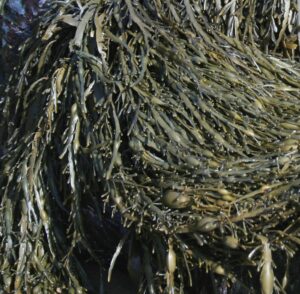Structure – block structure
The presence of three different types of polymer segment has been shown by mild acid hydrolysis (Haug et al 1966, 1967a, 1967b). one type of segment consists entirely of guluronic acid residues, one consists entirely of mannuronic acid residues and the third consists of an alternating sequence of mannuronic and guluronic acid residues. because the mild acid hydrolysis is not very selective it is difficult to say how long the segments are, but it appears that the average segment could be up to eighty residues long. the ratio’s of the three different types of segments for the various types of alginate have been determined using the partial hydrolysis method. recently it has been suggested, from studies on the enzymatic hydrolysis of alginate, that some deviation exists from the idealised, regular and alternating sequence (Morris et al 1978; Boyd 1975).

NMR has been sued to provide information, not only on the ratio of the two polyuronates, but also on the sequential distribution of the residues within the chainand their configuration. The shape of the NMR peaks can be used to provide information on the coupling constants and the relaxation times which subsequently provides information about the chemical environment of the atom under examination. The peaks can be used to provide statistical information on the sequences found with an alginate sample (Casu 1982; Grasdalen et al 1977, 1979a, 1979b, 1981, 1983). By initially partially hydrolysing a sample of alginate and then analysing the proton NMR, ratios for the three blocks within the co-polymer could be obtained (Penman and Sanderson 1972). The observations about the configuration of the alginate residues corroborates the findings of Atkin’s X-ray work (Atkins 1970). High resolution proton NMR on a partially hydrolysed sample has been used to provide information on the L-guluronic to D-mannuronic acid ratios. The frequencies for the four diads were calculated (MM, MG, GM, GG) by using a sequence dependant affect upon the H-5 of the guluronic acid residues (Grasdalen et al, 1979a). This was later extended to include all the triad groups centred on L-guluronic acid (Grasdalen 1983). Similar work has been carried out using 13C NMR in place of proton NMR (Grasdalen 1979b and 1981). This work gives an idea of the ratios of the three blocks within different samples. Different seaweed sources seem to provide widely differing alginates. Laminaria digitata seems to consist of large amounts of poly β-D-mannuronic acid blocks and poly α-L-Guluronic acid blocks whereas the alginate from macrocystis pyrifera appears to contain a large portion of both poly α-L-guluronic acid blocks and alternating blocks (Grasdalen 1983; Grasdalen et al 1981).
2-dimensional COSY proton NMR has been used to provide block structure information on bacterial alginates as well as information on the level of acetylation and the position of the acetyl groups within the polymer (Skjak-Braek et al 1986).
Sodium-23 NMR has been used to provide information on the rate of exchange of Na+ for polymer bound sodium ions using the relaxation times of the sodium NMR (Grasdalen & Kvam, 1986).
Additional information on alginate structure, production and bacterial alginate can be accessed using the arrows in the Further Reading box below.
Further Reading
Read more on Alginate
